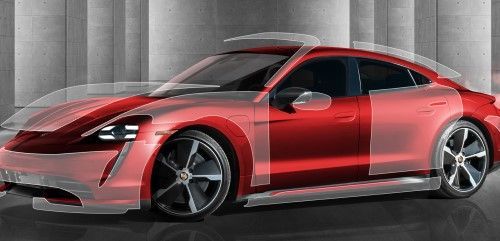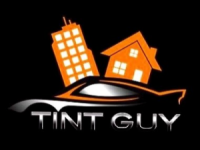WINDOW TINTING / PAINT PROTECTION
Absorbance - The amount of something (in the case of window films, light or heat) that is retained. See also Total Solar Absorbance.
Deposition Process - Physical vapor deposition (PVD) on metal films takes place when it is passed through heated metal and argon gas in a pressurized room. This helps to remove particles that may be on the surface of the film.
Dual-Reflective Film - An interior film that has a silver, reflective finish on the outside and a neutral finish on the inside. This is commonly referred to as “one-way mirror” film, although it comes in lighter shades that do not give as much privacy.
Dyed Film - A film that achieves its color and look by adding a dye to the film’s surface or adhesive. This is commonly done on automotive films. Also known as “Non-Reflective” film.
Emissivity - A measurement of how well a surface either absorbs or reflects infrared light/radiation. A lower number means the surface rejects more and thus insulates better.
Exterior Visible Light Transmission (VLT) - The amount of visible light that is passed through the glass from the outside. This measurement is commonly used on Dual-Reflective Film. See also Interior Visible Light Transmission (VLT).
Glare Reduction - The total amount of visible light that is rejected by a surface. This is typically the inverse of VLT. See also Visible Light Transmission.
Hybrid Film - A film that uses both the processes of a metallized film and a dyed film to achieve its color and look. See also Dyed Film and Metallized Film.
Infrared Light - More commonly referred to as heat, “infra” is the suffix for “below”. Electromagnetic radiation (light) with a wavelength between 0. 7 micrometers (0.0007 millimeters) and 1 millimeter, which is longer than visible light’s waves but shorter than microwaves.
Interior Visible Light Transmission (VLT) - The amount of visible light that is passed through the glass from the inside. This measurement is commonly used on Dual-Reflective Film. See also Exterior Visible Light Transmission (VLT).
Matte Film - Also known as “Frost Film”, these provide excellent privacy with a sand-blasted effect.
Metallized Film - A film that achieves its color and look by adding a metal layer to the film’s surface, either through a Sputtering or Deposition Process. This is commonly done on flat-glass films as well as high-performance automotive films.
Mil - The most common unit of measurement for the thickness of window film. Equal to 1/1000 of an inch (.001″).
Natural Film - Also known as “Neutral Film”, this film generally has a non-reflective look to it. It still contains metal, however.
Polyester Film - The most common base material used in window film. Manufactured from chemical substrates in petroleum.
Pressure-Sensitive Adhesive - An adhesive that is sticky to the touch when the protective liner is removed from the film. This adhesive works to bond much more quickly to glass and is commonly found on automotive films. See also Water-Activated Adhesive.
Reflectance - The amount of something (in the case of window films, light or heat) that is rejected away. See also Total Solar Reflectance.
Safety Film - Films used for increased glass protection. Most standard window films are 1.5 Mil thick, while a safety film is typically 4-Mil thick or greater.
Shading Coefficient - A ratio derived from dividing the amount of solar heat gain passed through the window film by the same amount that occurs through a normal, untinted window. The lower the number, the better the solar properties of the window film.
Solar Heat Gain Coefficient - A ratio derived from dividing the amount of solar heat gain passed through the window film by the amount of heat transmitted at normal solar incidence (completely perpendicular to the glass). The lower the number, the better the solar properties of the window film.
Sputtering Process - Physical vapor deposition (PVD) on metal films takes place when metal atoms are bounced off a charged metal disk of ions, which causes the atoms to build up on the polyester film.
Total Solar Absorbance - The amount of heat and light absorbed by the window film. See Absorbance.
Total Solar Energy Rejected - The amount of heat and light rejected by the window film.
Total Solar Reflectance - The amount of heat and light absorbed by the window film. See Reflectance.
Total Solar Transmittance - The amount of heat and light transmitted by the window film. See Transmittance.
Transmittance - The amount of something (in the case of window films, light or heat) that is transmitted through. See also Total Solar Transmittance.
U-Value - How well heat transfers through 1 square foot of window film for each 1° fahrenheit difference in temperature. This value also takes into consideration the local climate that the window is located in (i.e. geographical region, time of year, etc.) The lower this value, the better the glass and film will insulate.
Ultra Violet Light - More commonly referred to as UV rays, these wavelengths are shorter and have higher energy than visible light.
Ultra Violet Radiation Rejected - The percentage of Ultra Violet Light that is rejected by the window film.
Visible Light - The wavelengths in the light spectrum that are visible to the human eye. Ranges from red light (longer wavelengths) to violet light (shorter wavelengths).
Visible Light Transmittance - The amount of visible light that is passed through the glass.
Water-Activated Adhesive - An adhesive that is dry to the touch when the protective liner is removed from the film. This adhesive works to help the film move around on the glass easily during installation and is commonly found on flat-glass films. See also Pressure-Sensitive Adhesives.
Our Window Tinting Services...
From cars and trucks to homes and offices, we're your local experts in window tinting. Whether you need tinting for your vehicle or property, trust us for quality results and exceptional service.
Auto Tint
Tinting your vehicle not only adds
UV Protection,
Privacy, and
Anti-Fade
interior
protection but also
adds style to your vehicle, while simultaneously
rejecting heat and reducing the need for air conditioning, leading to improved mileage per charge, especially during hot summer months.
UV Protection
Privacy
Anti-Fade
Home Tint
We offer innovative solar, security, and specialty film solutions for better living at home. Our solar films provide OEM-grade protection, effectively blocking UV rays and heat while preserving views, offering
UV Protection,
Privacy, and
Energy Saving benefits.
UV Protection
Privacy
Energy Saving
Commercial Film
Have a commercial business with a office that can benefit from commercial window film? Experience the advantages of
UV Protection,
Privacy, and
Energy Saving with our tailored commercial tinting solutions. Contact us with your project requirements

Paint Protection Film / Clear Bra
In addition to window tint, we're also paint protection film installers. Safeguard your vehicle from rock chips, salt, insects, and other road debris with our professional installation.
Quick Links
Contact Info
(513) 942-7710
info@tintguy.com
Our Hours
Mon-Fri 9:00am - 5:00pm | Open on Select Saturdays
© 2024 TINT GUY WINDOW TINTING | PRIVACY POLICY | SITE MAP


